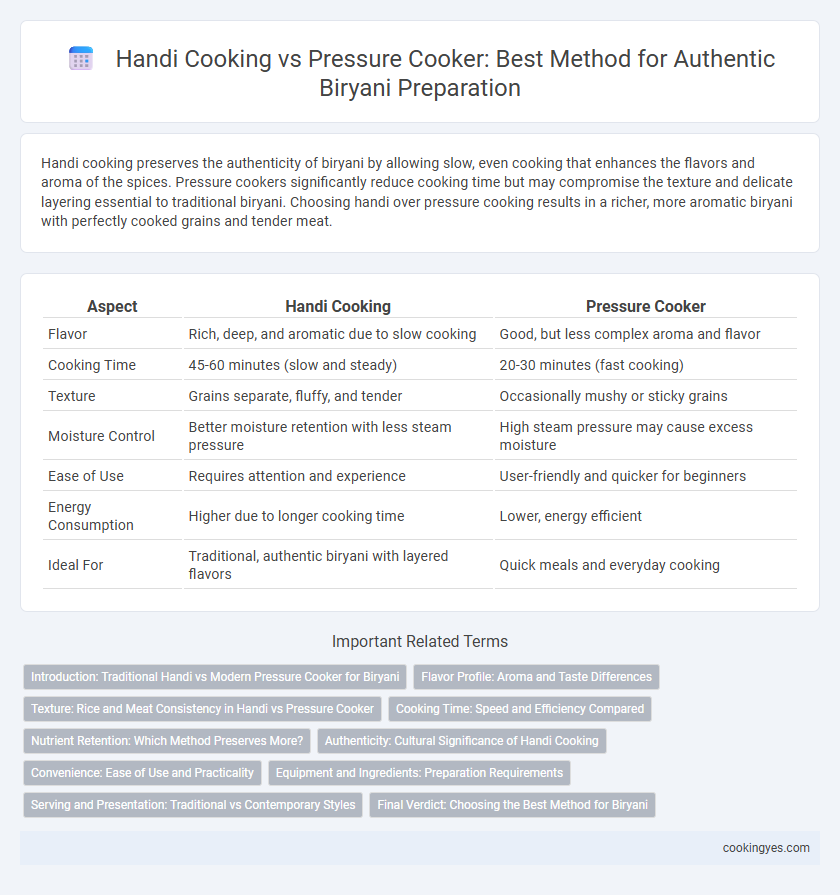Handi cooking preserves the authenticity of biryani by allowing slow, even cooking that enhances the flavors and aroma of the spices. Pressure cookers significantly reduce cooking time but may compromise the texture and delicate layering essential to traditional biryani. Choosing handi over pressure cooking results in a richer, more aromatic biryani with perfectly cooked grains and tender meat.
Table of Comparison
| Aspect | Handi Cooking | Pressure Cooker |
|---|---|---|
| Flavor | Rich, deep, and aromatic due to slow cooking | Good, but less complex aroma and flavor |
| Cooking Time | 45-60 minutes (slow and steady) | 20-30 minutes (fast cooking) |
| Texture | Grains separate, fluffy, and tender | Occasionally mushy or sticky grains |
| Moisture Control | Better moisture retention with less steam pressure | High steam pressure may cause excess moisture |
| Ease of Use | Requires attention and experience | User-friendly and quicker for beginners |
| Energy Consumption | Higher due to longer cooking time | Lower, energy efficient |
| Ideal For | Traditional, authentic biryani with layered flavors | Quick meals and everyday cooking |
Introduction: Traditional Handi vs Modern Pressure Cooker for Biryani
Cooking biryani in a traditional handi enhances flavor through slow, even heat distribution and natural steam sealing, preserving the rich aromas and texture of each ingredient. The pressure cooker significantly reduces cooking time by using high pressure to tenderize meat and cook rice quickly, making it a practical choice for busy kitchens. While the handi method prioritizes authentic taste and texture, the pressure cooker offers efficiency and convenience without compromising the essential elements of biryani.
Flavor Profile: Aroma and Taste Differences
Handi cooking enhances biryani's flavor profile by allowing slow, even heat distribution, resulting in a richer aroma and deeper, well-developed taste with tender meat and perfectly infused spices. Pressure cooker biryani, while faster, often lacks the nuanced fragrance and complex flavor layers created by gradual simmering in a handi. The sealed environment of a pressure cooker can diminish the depth of aroma and subtlety in the blend of cardamom, saffron, and other spices that hallmark traditional handi biryani.
Texture: Rice and Meat Consistency in Handi vs Pressure Cooker
Cooking biryani in a handi allows for slow, even heat distribution that preserves the distinct, fluffy texture of rice grains and tender, well-infused meat. Pressure cookers accelerate cooking with high pressure, often resulting in softer rice and denser meat, which can lead to a less layered texture. The handi method excels in maintaining separate rice grains and succulent meat, while pressure cooking may cause some mushiness due to rapid steam pressure.
Cooking Time: Speed and Efficiency Compared
Handi cooking biryani typically takes 60 to 90 minutes, allowing gradual heat distribution that enhances flavor and texture. Pressure cookers reduce cooking time to around 20 to 30 minutes by trapping steam and increasing temperature, offering speed and energy efficiency. However, the faster pressure cooker method may sacrifice the layered aroma and traditional texture characteristic of handi-cooked biryani.
Nutrient Retention: Which Method Preserves More?
Cooking biryani in a handi preserves more nutrients compared to using a pressure cooker due to the slower cooking process and lower heat exposure, which minimizes nutrient loss. Handi cooking allows the spices and ingredients to infuse gradually, maintaining the richness of vitamins and minerals. In contrast, pressure cooking, while faster, may lead to higher nutrient degradation because of the intense heat and pressure applied.
Authenticity: Cultural Significance of Handi Cooking
Handi cooking preserves the authentic aroma and texture of biryani by slow-cooking the ingredients over a gentle flame, allowing spices to meld naturally and rice to absorb flavors fully. This traditional method holds deep cultural significance, reflecting centuries-old culinary practices that emphasize patience and craftsmanship. In contrast, pressure cookers expedite the process but often compromise the layered taste and delicate fragrance that define a genuine handi-prepared biryani.
Convenience: Ease of Use and Practicality
Handi cooking for biryani offers traditional flavor infusion through slow, even heat, but requires constant monitoring and longer preparation time. Pressure cookers significantly reduce cooking duration by trapping steam and heat, making them easier and more practical for quick meal prep. For convenience, pressure cookers provide a user-friendly, efficient method that suits modern kitchens while still achieving tender, flavorful biryani.
Equipment and Ingredients: Preparation Requirements
Handi cooking for biryani requires a heavy, wide-mouthed clay or metal pot that evenly distributes heat and allows slow, uniform cooking, enhancing the aroma and texture of spices like saffron and cardamom. Pressure cookers demand precise timing and less liquid, as the sealed environment quickly infuses flavors but can overcook delicate ingredients like basmati rice and meat if not monitored. Using a handi encourages layering ingredients such as marinated meat, soaked rice, and fried onions for gradual flavor melding, whereas pressure cookers rely on pressure and steam to accelerate the infusion process, impacting the final biryani texture and moisture content.
Serving and Presentation: Traditional vs Contemporary Styles
Handi cooking enhances biryani's serving and presentation with its traditional clay pot, allowing aromatic steam to infuse the dish while maintaining layered textures and visual appeal, perfect for ceremonial occasions. Pressure cookers offer a contemporary style, enabling faster preparation and uniform cooking but often result in a more compact and less separated grain structure, affecting the dish's aesthetic and serving elegance. The choice influences the dining experience by balancing authentic rustic presentation against modern convenience and efficiency in plating biryani.
Final Verdict: Choosing the Best Method for Biryani
Handi cooking preserves the authentic flavors and texture of biryani by allowing slow, even heat distribution, resulting in tender meat and perfectly infused spices. Pressure cookers speed up the cooking process but may compromise the delicate layering and aroma essential to biryani. For traditional taste and superior quality, handi cooking remains the preferred method among biryani connoisseurs.
Handi cooking vs Pressure cooker for biryani preparation Infographic

 cookingyes.com
cookingyes.com